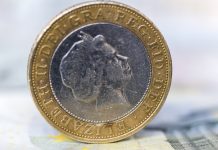The pound continued to slide versus the Australian dollar with little respite. The previous session saw the pound Australian exchange rate dump 1% as political turmoil in the UK soured appetite towards the sterling.
Heading into Tuesday, the pound was trading at A$1.6758, surpassing even the low reached on Friday morning following the UK elections. The pound has wiped out all the gains made against the Australian dollar since the announcement of the snap general election back in mid-April.
| What do these figures mean? |
|---|
| When measuring the value of a pair of currencies, one set equals 1 unit and the other shows the current equivalent. As the market moves, the amount will vary from minute to minute. |
| For example, it could be written: 1 GBP = 1.72119 AUD |
| Here, £1 is equivalent to approximately A$1.72. This specifically measures the pound’s worth against the Australian dollar. If the Aussie dollar amount increases in this pairing, it’s positive for the pound. |
| Or, if you were looking at it the other way around: 1 AUD = 0.57677 GBP |
| In this example, A$1 is equivalent to approximately £0.58. This measures the Australian dollar’s worth versus the British pound. If the sterling number gets larger, it’s good news for the Aussie dollar. |
Following UK Prime Minister Theresa May’s failed attempt to increase the working majority of the UK Conservative party in Parliament, the pound has plummeted. Whilst on Friday and over the weekend investors were entertaining the thought of a softer Brexit, Monday saw the focus shift firmly onto the political uncertainty that the disastrous election has brought with it.
Large doubts had formed as to whether Theresa May was going to be able to cling onto her job as Prime Minister, amid talk of one of her own party pushing her out of power. Following a tough meeting with backbenchers of May’s party, the UK Conservatives have decided to continue supporting Theresa May as Prime Minister. Consequently, this offered the pound some support versus other peers, although this wasn’t so much the case with the Australian dollar.
| How does political stability boost a currency? |
|---|
| Political stability boosts both consumer and business confidence, which means corporations and regular households alike are more likely to spend money. The increased spending, in turn, then boosts the economy. Foreign investors prefer to invest their money in politically stable countries as well as those with strong economies. For foreign investors to put their money into an economy, they need local currency. As the acquire the money needed, the demand for that particular currency increases, which then boosts its value. |
UK political developments and political instability will continue to be the main driving force behind the pound Australian dollar exchange rate on Tuesday. As UK inflation data is due this morning, an above expectation reading is unlikely to move sterling too far northwards. However, given the fragility of the pound, bad news could prove too much for the pound to deal with and send sterling considerably lower.
Demand for Australian dollar steady ahead of Thursday’s Australian employment data
The UK political situation is expected to dominate pound Australian dollar exchange rate movement, at least until Thursday. On Thursday, the release of the Australian employment report for May could give investors invaluable insight into how healthy the Australian labour market is. Any signs that unemployment is shifting lower that 5.75% could boost the Australian dollar into the end of the week.
| How does strong jobs data boost the currency? |
|---|
| It works like this, when there is low unemployment and high job creation, the demand for workers increases. As demand for workers goes up, wages for those workers also go up. Which means the workers are now taking home more money to spend on cars, houses or in the shops. As a result, demand for goods and services also increase, pushing the prices of the good and services higher. That’s also known as inflation. When inflation moves higher, central banks are more likely to raise interest rates, which then pushes the worth of the currency higher. |
This publication is provided for general information purposes only and is not intended to cover every aspect of the topics with which it deals. It is not intended to amount to advice on which you should rely. You must obtain professional or specialist advice before taking, or refraining from, any action on the basis of the content in this publication. The information in this publication does not constitute legal, tax or other professional advice from TransferWise Inc., Currency Live or its affiliates. Prior results do not guarantee a similar outcome. We make no representations, warranties or guarantees, whether express or implied, that the content in the publication is accurate, complete or up to date. Consult our risk warning page for more details.
This article was initially published on TransferWise.com from the same author. The content at Currency Live is the sole opinion of the authors and in no way reflects the views of TransferWise Inc.





